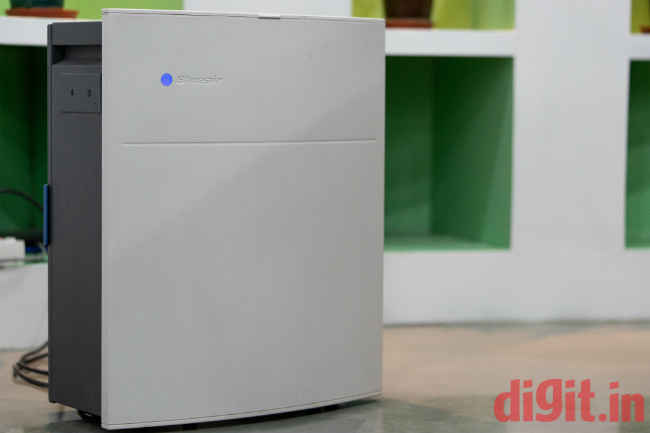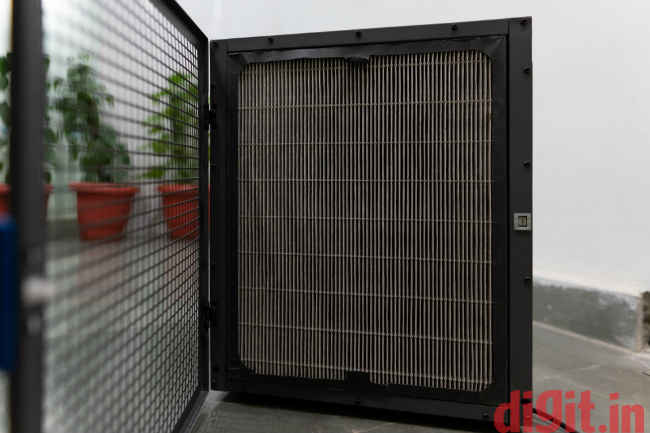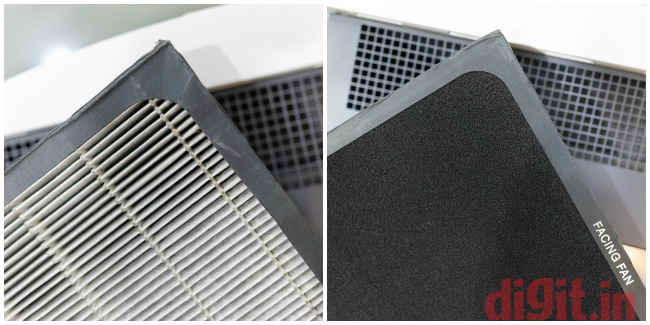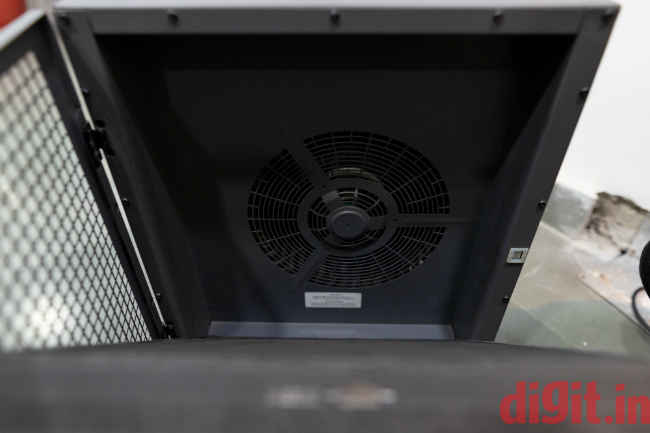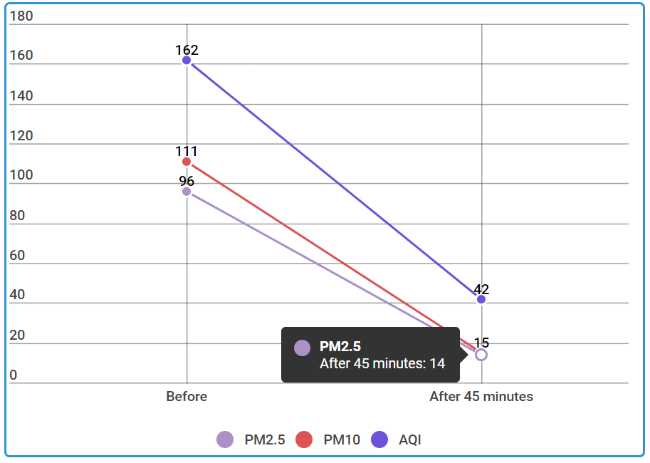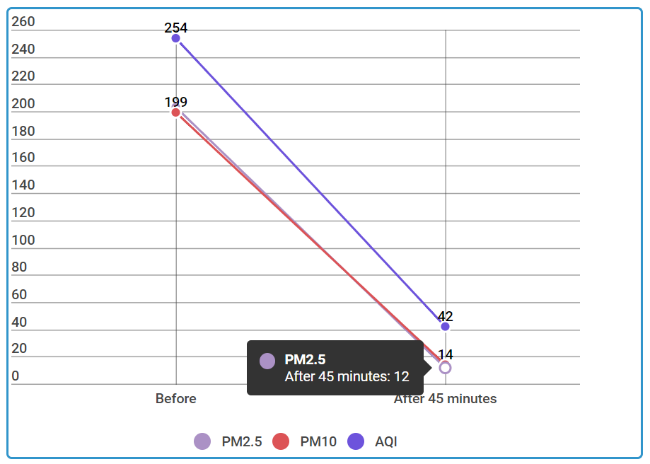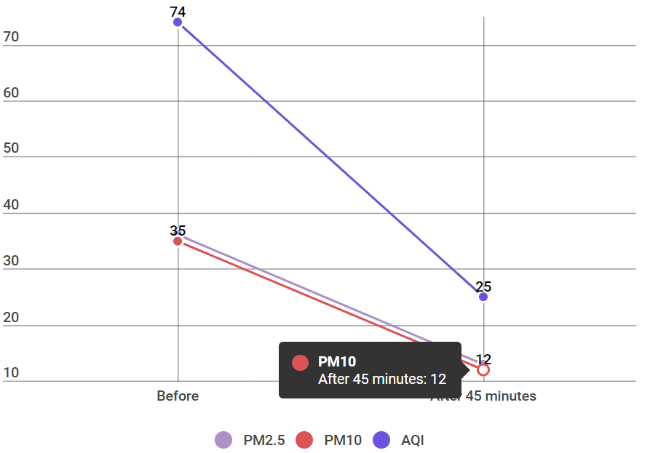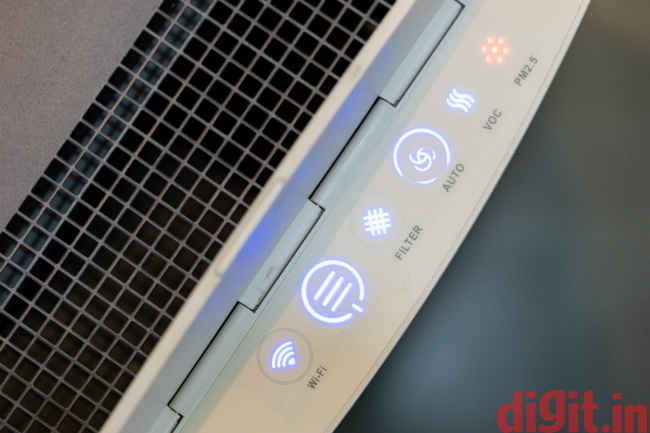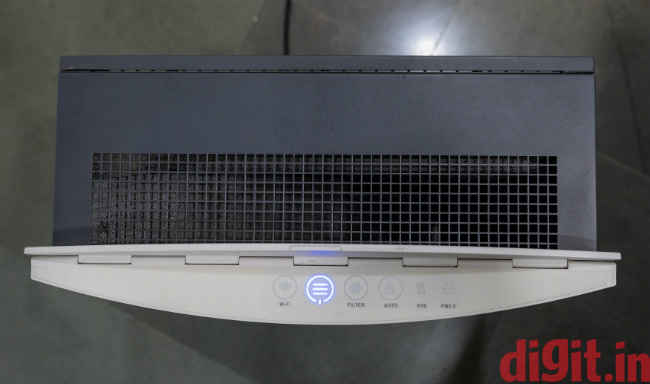Blueair Classic 280i Review : Function over form
While most air purifiers make tall claims, there are few that actually manage to deliver convincing results. The Blueair Classic 280i air purifier is quite efficient when it comes to air purification and it could’ve been even better if not for some shortcomings like the lack of a better functioning app. However, we recommend the Classic 280i as it’s able to achieve its primary purpose, air purification, rather well.
Build and design
Blueair says that the Classic 280i features a “timeless design”. What this means is that you get a chunky block of technology, which one need worry about being easily damaged. The air purifier is designed with simple aesthetics so that it can easily blend in with standard home decor to do its job inconspicuously. The Blueair 280i air purifier sports plastic on the front, while the rear and its sides are made of galvanized steel. The device exhibits solid build and one need not worry about accidentally toppling the thing over as it weighs 10kg. Its power cord is not detachable but if it was, it would’ve made the air purifier a lot easier to transport.
The Classic 280i sports one of the most simplistic designs we have come across while reviewing an air purifier. It sucks in air from the rear, filters it in the process and expels it out of the top. As it hurls air out at an inclined angle, one can place it in such a manner that it acts as a fan, but for only one person. After reviewing the Dyson Pure Cool, we do think that there needs to be some innovation in the standard box type air purifier design but overall, the device has a simple, functional design.
Filters
The design is not the only area where the Blueair Classic 280i keeps things simple. The device comes equipped with a single filter which takes care of air purification. There’s no pre-filter, or a separate carbon filter or a post filter. To make things easier for the user, all the three have been collated into one for ease of use and replacement. However, as there are a lesser number of filters, one might think that the air filtration capabilities of the device might not be at par with its competitors, which would generally be true. However, as we will discover in the next section, this is not the case with the Blueair Classic 280i.
Blueair offers two kinds of filters to select from for the device. One is a particle filter that traps PM2.5, pollen, dust, mold, and pet dander, while the other one is a SmokeStop filter that features activated carbon that, alongside all the aforementioned solid particulates, is also capable of removing harmful Total Organic Volatile compounds or TVOCs from the air. The SmokeStop filter can also help clear smoke, odours and chemical vapours from the air in a room.
Both the filters will last you for around 4,380 hours or six months but the Particle filter is priced at Rs 4,500, while the SmokeStop filter will cost you 6,000. We suggest the SmokeStop filter for anyone who is buying this air purifier as TVOCs and airborne chemicals pose as much of a health risk as the solid pollutants suspended the air. As the unit we reviewed came equipped with the SmokeStop filter, our review is based upon the device’s performance with this filter only. Replacing the filter is also easy as one simply needs to tug on the back grill, remove the existing filer and place a new one.
The filter used in the air purifier measures 454 mm x 365 mm x 45mm and is reasonably large in size. The larger size of the filter means more surface area for the particulate matter to be trapped in and larger adsorption area to eliminate harmful gases. However, with such a large filter, the airflow would normally be adversely affected and an air purifier tends to make more noise and draw more power as it needs to work harder while pulling the air in. Surprisingly, this is not the case with the Classic 280i. This is because the filter is not extremely dense and this results in lowered noise levels as the air easily passes through the filter.
Now, one might be thinking that since the filter is not dense enough, is it efficient in trapping particulates in the air? Blueair says that because of their HEPASilent technology, their filters are 99.97 percent efficient at capturing particles down to 0.1 microns in size. HEPASilent is actually the company’s proprietary technology employed for capturing polluting elements passing through its air purifiers. The only thing different here is the use of electrostatic charge for trapping the ultrafine particulates that are less than 0.3µm in size.
We have reached out to Blueair for some clarification on how exactly the electrostatic charge is imparted onto the pollutants. One should note that there are various methods like electrostatic precipitation, ionisation and more for achieving this but if ionisation is used, it could generate ozone, which is harmful and can cause difficulty in breathing, lung and/or skin irritation and other problems. However, Blueair does claim that their air purifier is certified to not generate ozone and that it actually reduces it. We will update the review as soon as we get an answer to these questions.
Performance
In order to evaluate the Blueair Classic 280i’s performance, we tested its efficiency in three different areas with varying levels of air pollution, for a total of 45 minutes. This process is aimed at providing a fair idea of how the device will perform in relatively similar situations, in the buyers’ own home. We tested the air purifier in three rooms where room 1 usually observes a high level of indoor air pollution as it’s nearby a flyover where some construction is also going on. It has an area of 120 sq ft with a ceiling height of 12 ft. Room 2 is in a high-rise apartment flat where the air quality is fairly moderate. It has a ceiling height and area of 12 ft and 140 sq ft respectively. Finally, the room 3 is one of the conference rooms in our office, which has relatively lesser indoor pollution. Its area is 350 sq ft with a ceiling height of 12 ft.
While the particulate levels are almost never under permissible limits in room 1, they fluctuate in-between in room 2. The particulate levels are usually near permissible levels in room 3. It should be noted that in India, the permissible limit of PM2.5 is 40 µm/m3, while for PM10 it’s 60 µm/m3. So, if the air purifier is to bring the Indoor Air Quality (IAQ) to a satisfactory level, these numbers should be below the aforementioned permissible limits and in fact, they should go as low as possible. Even though the Blueair Classic 280i comes equipped with its own sensors, we made use of two separate air quality monitors to independently assess whether the air purifier was making a difference in IAQ or not.
One of the air quality monitors used in our assessments is the AirVisual Pro, which displays the overall Air Quality Index (AQI) based PM2.5 levels. The device is tuned per the Indian pollution standards, which are different from other countries and the AQI is also slightly different. This reading is a good way to ascertain whether the overall air quality is up to the mark or not as it is determined based on the worst sub-index from a range of polluting elements. In India, AQI is considered good or satisfactory if it’s between 0-100, moderate between 101-200, poor between 301-400, very poor and severe when it’s between 301-400 and 401-500 respectively. Even though AQI can be considered a simple way to assess the overall IAQ, one should never solely rely on it and also consider PM2.5 and PM10 particle concentrations.
Do note that all the PM2.5 and PM10 levels mentioned here are in µg/m3. Starting with the room 1, the overall AQI was in the moderate range at 162, while the PM2.5 and PM10 levels were at 96 and 111 respectively. Now, even though the room 1 exhibits higher pollution levels, they were in the moderate range this time around. After letting the Blueair Classic 280i run for about 45 minutes, the AQI was brought down to 42 and the PM2.5 and PM10 levels were down to 14 and 15 respectively. This level is performance is relatively good but not quite conclusive as the air purifier is yet to face higher levels of pollution levels.
As mentioned earlier the IAQ levels are usually moderate in the room 2. However, the PM2.5, PM10 and the overall AQI levels were already in the satisfactory range this time around. In order to give the air purifier a chance to prove its worth, we introduced smoke from one cigarette in the room and waited 15 minutes before running the test so that the natural decay of particulates doesn’t interfere with our readings.
The initial PM2.5 and PM10 readings before commencing the test were 193 and 199 respectively, while the AQI shot up to 254, straight into the ‘poor’ range. After letting the air purifier run for 45 minutes at its highest speed setting, the AQI was brought down to 42, and the PM2.5 and PM10 levels to 12 and 14 respectively. The readings indicate that the Blueair Classic 280i is capable of efficient air purification in a fairly average amount of time. However, we did let the air purifier run for another 30 minutes and it brought the AQI level further down to 13 and both, the PM2.5 and PM10 levels to 3. We observed a similar level of performance while reviewing the IQAir HealthPro 250 air purifier, but it should definitely not be compared with Blueair as it produced better results in merely 30 minutes and costs a little over one lakh rupees.
The air quality was least degraded in the room 3, however, the Blueair Classic 280i still managed to lower the PM2.5 particulates from 36 to 13, PM10 from 35 to 12 and the AQI from 74 to 25. The performance here is as expected as the already lowered numbers actually make it difficult for an air purifier to improve the air quality further.
Here is the breakdown of how the Blueair Classic 280i scores in our tests:
| Features | 69 |
| Design & Usability | 76 |
| Performance | 87 |
| Value for Money | 65 |
The air purifier sports almost all the features one would want from an IoT enabled air purifier. However, there are some considerable drawbacks because of which it lags behind the competition but we will talk about what’s missing or what could be better in terms of features in the next section. We have already gone over the device’s design and performance, where it has done well. Coming to its value for money factor, we believe that the Blueair Classic could have scored higher if it had been priced slightly lower than Rs 36,999.
Controls
The Blueair Classic 280i features a flap on the top and raising it reveals its LED-backlit touch buttons. There is no on/off button but tapping on the one that looks like the hamburger menu from an app turns the air purifier on at the slowest speed setting. Tap on it twice and it will bump up the device’s speed to maximum. Granular control over the air purifier’s speed would have certainly worked better though. Starting with the left, the first button displays the current Wi-Fi connection status and next to it is the button to control the fan speed. Then, there is an LED indicator to display the filter life, which starts out with the colour blue when the filters are new. It turns orange to indicate that it’s time to get a replacement.
The Classic 280i comes equipped with two air quality sensors and there’s an auto mode button for making use of them. One switched to auto mode, the air purifier senses the level of pollutants and TVOCs in the air and adjusts its speed accordingly. Additionally, there are buttons to indicate the level of VOC and PM2.5 levels in the air as well. They turn orange from blue when these particulates and gases rise past their permissible limits. The device would have won brownie points in our review if there was a digital display to show exact values instead of just colours like the Dyson Pure Cool or the Philips AC382, which are around the same price.
App connectivity
One can connect the air purifier with the Blueair Friend app to fully utilise its IoT capabilities. However, the app needs some serious redesign and as of writing this review, it has not been updated since June 2018. Connecting the Blueair Classic 208i with the app was easy enough but it takes an unbearable amount of time whenever you boot up the app and try to connect with the air purifier. Many times the app fails to register that the device is on and working as it will show the status as offline. When the app does work, it is excruciatingly slow to such a degree that one will learn to practice patience when moving between menus and screens or while trying to remotely operate the Classic 280i.
After setting up and pairing the app with the Blueair Classic 280i, one will be greeted with an overall graph of various metrics. Circular tabs show current metrics like PM2.5, TVOCs, equivalent CO2 levels, along with current temperature and humidity of the room where the air purifier is placed. All of the mentioned particulate and gas levels are represented as a graph and one can select to view live readings or a graph of these values over a day, a week, or a month. The overall UI of the app is clean and intuitive.
The app also enables remotely controlling the fan speed, changing the brightness of the LED buttons, enable child lock, and the Night Mode. Within Night Mode, one can also set a schedule for when the air purifier should run including what days of the week. It would have been better if Night Mode was simply called schedule as that would better describe the nested options. Overall, the app needs a major update to work seamlessly with the air purifier. There is also no physical remote to control the device, which is a let down considering the current state of the Blueair Friend app.
Bottomline
The Blueair Classic 280i is efficient and silent, which is a rare combination when it comes to air purifiers. With a sturdy build and high-quality filters, it gets the job done by cleaning the air of harmful particulate particles and gases, given a reasonable amount of time. What it lags behind in is IoT capabilities and how they are implemented in-app. If the company can fix things on that front, the Blueair Classic 280i will be an all-rounder that is definitely recommended.
In case you want an air purifier that also performs well and is packed with features, but priced a tad higher, you can go for the Dyson Pure Cool air purifier (review). In case you want something under a tight budget, you can check out the like the Mi Air Purifier 2 (review) or the Kent Alps (review). On the contrary, if you want the best possible performance, check out the high-end IQAir HealthPro 250 (review) air purifier that manages to justify its hefty price tag of over Rs 1 lakh with excellent performance.
–With inputs from Adamya Sharma and Swapnil Mathur

